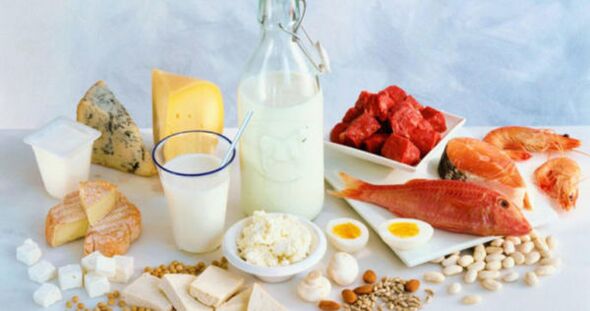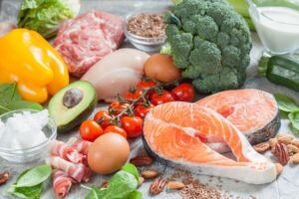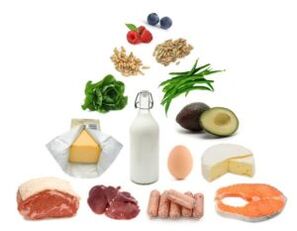
The ketogenic diet, after becoming known to the general public, immediately attracted attention and became a favorite among show business stars.Doctors, nutritionists, doctors and athletes have not yet agreed on its influence and effectiveness, but the number of followers of this diet grows every year.
What is the ketogenic diet?
ketogenic diet- This is a low-carbohydrate diet, which is characterized by a high dietary fat content and a moderate amount of protein.
The daily intake of nutrients is distributed as follows:
- up to 10% carbohydrates;
- 50-60% fat;
- 30-40% proteins.
Due to the low carbohydrate content in the daily menu, the body converts lipids into fatty acids and ketone bodies.The latter enter the brain and serve as a source of energy instead of glucose.This process is called ketosis, hence the name of the diet.
The essence of the keto diet.
The peculiarity of the diet is the absolute exclusion of rapidly digestible carbohydrates and most complex carbohydrates, as well as drinks containing caffeine.The diet is based on fatty meat products and saturated fats.
This style of eating puts the body in a state of stress, in which acetone (ketone bodies) are dynamically produced.The latter, in turn, helps suppress appetite.In ketosis, the body is forced to adapt to burning the subcutaneous fat layer.
Initially, this nutritional method was not intended to combat excess weight.It was believed that it would be of great help in the treatment of certain diseases and in postoperative rehabilitation.
Basic principles
It is suitable for those who want to quickly lose a few centimeters of subcutaneous fat, athletes looking for a sculpted body and is also used in the rehabilitation of patients with epilepsy and oncology.This nutritional method is a quite complex and delicate process.
It is based on the following principles:
- reduce the amount of carbohydrates consumed to a minimum;
- strict control over sugar and starch entering the body;
- maintain drink balance;
- moderate physical activity;
- maintain the proportion of fats in the daily diet at 60%;
- protein-fat ratio 1:2;
- Smooth entry and exit from the diet.
Basic rules
Based on the above principles, the basic rules have logically been formed according to which it is necessary to change the lifestyle so that following the ketogenic diet is not a thoughtless and uncontrolled process that can significantly worsen the condition of the body.
So, diet rules:
- There is a reduction in the amount of carbohydrates in the daily diet during the first 8 to 14 days.
- The number of main meals is at least 5 a day, but 7 is already a lot.
- You need to eat every 3.5 to 4 hours.
- Look at the portion: it should be small.
- It is advisable to avoid snacking between “authorized” meals.
- The effect of the diet occurs only if it is strictly followed.
- It is required to increase the volume of clean water consumed to 3 liters per day.
- For people who want to follow this nutritional method, without medical indications, consultation with a specialist is necessary.
- Do not worry about the amount of lipids in the daily menu: with this style of nutrition, they are the main source of energy for the human body.
- The intensity of physical activity should not be excessively high.
- To get into ketosis as quickly as possible, some people practice fasting.Such a radical method is possible, but only if there are no contraindications and the body is completely healthy and strong.
The ketogenic diet involves giving up some foods and leaning more on others.To better control and calculate your nutrient intake, below you will find tables of desirable and prohibited foods.
Authorized products
The list of nutritional products allows:
- meat products, poultry;
- fish, seafood;
- sausages, mayonnaise;
- fungus;
- some types of vegetables, herbs;
- dried fruits, nuts;
- milk, eggs;
- oils, fats;
- non-alcoholic drinks.
Prohibited products
When following a ketogenic diet, the following are strictly prohibited:
- starchy vegetables;
- pasta and bakery products, flours;
- cereals;
- confectionery;
- some types of fruits and juices;
- carbonated and caffeinated beverages;
- sweet milk and alcoholic beverages.
Diet to start and maintain ketosis.

The essence of the ketogenic diet is, as mentioned above, that the body replaces glycolysis with lipolysis.Simply put, it "switches" from the breakdown of carbohydrates to the breakdown of fats.This process is called ketosis.
When the amount of carbohydrates consumed per day reaches a minimum of 50 g, the formation of ketones begins.From this moment, the body begins to extract energy from fat cells and, consequently, the weight loss process begins.
Entering a state of ketosis does not happen instantly.It takes almost a week for the body to achieve the desired lipolysis.
This happens in four stages:
- Stage 1. Unconditional glucose consumption.Half a day after the last meal produced, the body will consume glucose.
- Stage 2. Glycogen processing.After glucose, the body turns to glycogen stores in the liver and muscles.This takes almost 48 hours.
- Stage 3. Processing of fats and proteins.Once the body runs out of carbohydrates, from which energy has returned, it moves on to the synthesis of muscle fibers and fatty acids.This is the most difficult step towards ketone formation.
- Stage 4. Fat consumption.Ketosis itself.When the body gets used to a minimum of carbohydrates and the protein burning process slows down, the consumption of fatty acids begins.
The diet to actively burn fat and, consequently, maintain ketosis, is based on the principle of the absolute benefit of fats in the menu.
As a percentage:
- fats – from 60 to 75%;
- proteins – from 25 to 35%;
- carbohydrates – up to 10%.
It should be noted thatYou shouldn't stop counting calories.The ketogenic diet, like other nutritional methods, requires taking nutrients into account.Especially if the goal of following it is to lose weight.
To calculate the required amount of nutrients per day, you can use a simple calculation: 1 g of protein per kilogram of body weight, and carbohydrates and fats are allocated as a percentage.
For example, if a person weighs 80 kg, then 80 g of protein, 300 g of lipids and 20 g of carbon are needed per day.If you feel weak during the transition period (the first week), you can increase the number of grams of the last nutrient, but not more than 50 units.
There is no fundamental gender difference when it comes to creating an appropriate diet.Basically, if the type of ketogenic diet is not taken into account, the menus of women and men differ in the amount of protein consumed.Men, to maintain muscle mass, need a greater amount of the nutrient.
Example of a ketogenic diet menu for a week
For men
An approximate budget menu for men looks like this:
| day | eating |
| 1 | First: omelet – 80 g, veal cutlet – 120 g, tea – 120 g Second: chicken breast – 130 g, vegetable salad – 130 g, gelatin – 230 g Third: cottage cheese – 160 g Room: baked fish with herbs – 120 g, brown rice – 80 g, tea – 200 g Fifth: protein shake – 200 g |
| 2 | First: whole grain rice pudding – 160 g, toast, tea – 120 g Second: Meat borscht – 240 g, chicken zrazy – 80 g, cabbage salad – 80 g, gelatin – 150 g Third: protein shake – 300 g Room: seafood salad – 180 g, toast with cheese – 70 g, tea – 200 g Fifth: casein |
| 3 | First: scrambled eggs with ham – 150 g, crackers – 15 g, tea – 120 g Second: chicken soup – 180 g, beef medallions – 90 g, vegetable salad – 140 g, tea – 180 g Third: cheese – 80 grams Room: Baked mushrooms – 120 g, vegetable salad – 150 g, tea – 200 g Fifth: unsweetened kefir – 230 g |
| 4 | First:Steamed fish cutlets – 160 g, vegetable salad – 130 g, tea – 120 g Second: borscht – 270 g, meat salad – 110 g, gelatin – 100 g Third: tortilla – 120 g Room: red fish – 110 g, toast with cheese – 60 g, tea – 200 g Fifth: protein shake – 250 g |
| 5 | First: boiled eggs – 3 pieces, baked fillet – 120 g, vegetable salad – 110 g, tea – 120 g Second: Puree soup – 260 g, meat salad – 130 g, gelatin – 200 g Third: rosehip tincture – 250 g, crackers – 20 g Room: Baked fish – 180 g, vegetable salad – 120 g, tea – 200 g Fifth: casein |
| 6 | First: omelet – 120 g, cottage cheese – 110 g, tea – 120 g Second: Fish soup – 260 g, vegetable salad – 130 g, chicken cutlets – 80 g, tea – 200 g Third: green apple puree – 70 g Room: Seafood salad – 160 g, boiled chicken – 110 g, tea – 200 g Fifth: protein shake – 200 g |
| 7 | First: casserole with mushrooms – 180 g, crackers – 10 g, tea – 200 g Second: chicken soup – 160 g, beef cutlets – 160 g, vegetable salad – 80 g, gelatin – 200 g Third: cottage cheese – 80 g Room: boiled fish – 130 g, vegetable salad – 110 g, tea – 200 g Fifth: unsweetened kefir – 180 g |
For women
Sample menu for women:
| day | eating |
| 1 | First:omelet – 130 g, meat salad – 130 g, tea – 120 g Second: meat broth – 210 g, brown rice stewed with vegetables – 180 g Third:cheese – 60 grams Room: Baked fish – 150 g, tea – 220 g Fifth: Riazhenka – 250 g |
| 2 | First:fish cutlet – 80 g, toast with ham – 75 g, rosehip tea – 130 g Second: Borscht – 200 g, fish cutlet – 75 g, meat salad – 125 g Third: avocado – 50 g Room: beef entrecote – 180 g, tea – 220 g Fifth: unsweetened kefir – 230 g |
| 3 | First:scrambled eggs with ham – 80 g, salad with cucumber and eggs – 120 g, tea – 120 g Second: poultry soup – 210 g, rabbit cutlet – 110 g, fresh vegetables – 80 g Third: tortilla – 160 g Room: Baked fish – 90 g, zucchini pancakes – 130 g, gelatin – 150 g Fifth: kefir – 230 g |
| 4 | First:boiled eggs – 3 pieces, meat salad – 160 g, nuts – 30 g Second: fish soup – 230 g, meat medallions – 80 g, vegetable salad – 110 g Third: cheese - 60 g Room: Beef pate – 60 g, cucumber salad – 120 g, tea – 220 g Fifth: Riazhenka – 250 g |
| 5 | First:turkey fillet – 120 g, meat salad – 110 g, green tea – 120 g Second: puree vegetable soup – 170 g, baked fish with brown rice – 170 g Third: walnuts –30 g Room: fried mushrooms with ham and vegetables – 230 g, tea – 220 g Fifth: green tea – 220 g |
| 6 | First:cottage cheese – 130 g, rosehip tea – 130 g Second: chicken broth – 130 g, pork chop breaded with cheese – 120 g Third: avocado – 50 g Room: sausages, ham, tea – 220 g Fifth: kefir – 230 g |
| 7 | First:omelet – 120 g, vegetable salad – 100 g, green tea – 120 g Second: mushroom soup with meat – 160 g, fried fish – 80 g, vegetable salad – 100 g Third: cheese – 80 grams Room: Cabbage rolls – 180 g, tea – 220 g Fifth: green tea – 200 g |
Recipes
This type of diet does not make you “hungry”, so choosing and combining dishes is not difficult.Here are some recipes that are easy to prepare and still stay in ketosis.
Special keto bread
Ingredients:
- eggs - 3 whites;
- almond flour - 0.25 cups;
- water – 0.25 cups;
- chopped banana – 50 g;
- baking powder – 10 g;
- apple cider vinegar – 10 g;
- sea salt – 5 g;
- sesame seeds (optional).
Preparation progress:

- mix the flour, plantain and baking powder;
- boil water, pour into a bowl with dry ingredients;
- add egg whites and vinegar;
- mix the dough with a mixer for 2-3 minutes until it is suitable for modeling;
- form future loaves in any shape;
- place on a greased baking sheet;
- sprinkle sesame seeds on top and place in the oven;
- bake at 200 degrees on the bottom shelf for about an hour;
- readiness is determined by tapping the bottom of the bread;
- the finished bread makes an "empty" sound.
Baked salmon with asparagus
Ingredients:
- salmon (fillet) – 1000 g;
- asparagus – 130 g;
- mushrooms – 250 g;
- onion – 40 g;
- garlic – 3 cloves;
- soy sauce – 300 ml;
- sesame oil – 10 g;
- butter – 20 g;
- basil – 3 g.
Preparation progress:
- mix soy sauce, basil and garlic;
- cut the fish fillet into pieces, place it in a sealed bag and pour over the resulting sauce with spices;
- and place in the refrigerator to marinate for 60 minutes;
- preheat the oven to 180 degrees;
- After the time, place the baking tray lined with aluminum foil in the oven with the fish and asparagus arranged;
- cook for 20 minutes;
- During this time, sauté the mushrooms and onion in a pan;
- then spread this mixture over the cooked fish;
- bake for another 10 minutes.
Chicken Casserole with Cheese and Olives
Ingredients:
- chicken (breasts) – 700 g;
- pesto sauce – 90 g;
- cream (whipped) – 400 ml;
- olives (marinated) – 200 g;
- feta cheese – 250 g;
- garlic - 1 clove;
- oil for frying;
- green;
- oil (olive) – 40 g;
- salt (sea) – 10 g.
Preparation progress:

- wash the meat, cut it into pieces, add salt;
- fry on both sides until golden brown;
- mix cream and pesto sauce in a bowl;
- place chicken in baking dish;
- Place finely chopped garlic, olives and cheese on top;
- pour sauce with cream;
- bake in the oven at 200 degrees for half an hour;
- When the edges of the dish become sandy, you can remove it: the casserole is ready.
roast meat
Ingredients:
- beef – 2 pieces without bones;
- onion – 1 piece;
- garlic – 1 clove;
- tomato – 2 pcs.;
- vinegar (apple) – 50 g;
- oil (olive) –30 g;
- ground ginger – 7 g;
- salt (sea) – 2 g.
Preparation progress:
- rinse the meat, make shallow cuts on top of the fillets;
- Peel the onion and cut it into small cubes;
- chop the tomatoes into cubes;
- Place fillets in a preheated skillet brushed with olive oil;
- brown on both sides over medium heat;
- then add tomato cubes, onion and crushed garlic to the meat;
- fry, stirring occasionally, 5 to 7 minutes;
- place ginger in a separate container, add salt and pour vinegar;
- add the resulting sauce to the meat, stir;
- turn on the fire at minimum intensity;
- cook with the lid closed until the liquid evaporates;
- When serving, sprinkle with herbs.
The effectiveness of the keto diet.
As already noted, there is no consensus on the effectiveness of this nutritional method.The ketogenic diet is quite controversial.It has contraindications, advantages and disadvantages.Not suitable for everyone.
But one thing is certain: as long as proper nutritional rules and principles are followed, a person following a ketogenic diet is "doomed" to lose 1 to 3 kg of weight per week.It is widely used by celebrities to get rid of extra centimeters, by athletes to create a sculpted body and it is also prescribed for certain diseases.
To increase the effectiveness of the diet, it is advisable to follow some rules:

- Choose a vitamin and mineral complex. to maintain the body.
- It is necessary to undergo a medical examination,to ensure that there are no contraindications to maintaining this style of eating.The ketogenic diet, except in certain cases, requires “iron” health.
- Carefully consider eliminating certain products.If it is not possible to limit yourself, for example, to eating bread or pasta, then it is better to choose a different nutritional method so as not to expose yourself to an even greater state of stress.
- In the first or second week, while the metabolic process is restructured, try not to lead your lifestyle to fanatical activity.and don't plan on too much physical and mental stress.When the body enters a ketotic state, there is unlikely to be an increase in athletic or mental performance.
- It takes some time and skill to form the habit of preparing meals correctly while following the ketogenic diet.Therefore, you should try to plan your day so that there is no opportunity to have an “unauthorized” snack.
- To minimize the negative effects of the diet, don't forget to include fiber-rich foods in your diet.They improve and normalize the functioning of the gastrointestinal tract.
- It is unlikely that you will be able to avoid the unpleasant smell of acetone, so it is recommended to double your consumption of clean water.Proper water balance is the key to effective weight loss.
- Equally important in the process of getting rid of unnecessary centimeters of fat is maintaining electrolyte balance.Lightly salted foods will not only improve the taste of dishes, but will also have a positive effect on your well-being.
Based on the set goals (be it weight loss, cutting, weight gain, etc.), the necessary diet option is selected.
Varieties
Classic (standard or basic)
- This type is considered the most common and simplest diet.
- It is characterized by a high dietary fat content, a medium protein content and an extremely minimal amount of carbohydrates.
- Recommended for people with no or low physical activity.
Addressed
- This variety consists of adding carbohydrates to the diet, but at certain times and in a certain volume.
- The so-called carbohydrate loading occurs on training days.
- To increase resistance and intensity, charcoal is consumed during the hours before training (before and after exercise).
- On rest days, to maintain ketosis, the amount of carbohydrates is kept to a minimum (0.5 or 1 g per kg of body weight), the fat level is slightly reduced so as not to exceed the calorie content of the daily diet.
cyclic
- This is an option for the "advanced".It involves regular feeding with carbohydrates.
- The pause between carbohydrate “sets” depends on the tasks, objectives and intensity of the physical activity.
- At the same time, the weight of fats in the diet is reduced, protein is increased, and 7 to 10 g of carbon per 1 kg of body weight is reduced.
- Charging time ranges from 8 to 36 hours.
- The intervals can be increased, taking into account the condition of the body.
- Recommended for people with high physical activity who feel weak due to lack of carbohydrates.
Indications
Diet shown:
- those who want to lose weight, lose weight, gain muscle mass;
- for epilepsy;
- for oncological diseases.
Benefits
- This method of eating is not "hunger."The feeling of hunger appears very rarely.
- Changing your metabolism through ketosis promotes rapid weight loss compared to other methods.
- There is no clear order to the menu;The dishes are quite varied.You just need to follow the nutrient intake formula.
- The value of following a ketogenic diet has been demonstrated for cancer, epilepsy, and other diseases.
- The products on the ketogenic diet whitelist have a low glycemic index.Its consumption has a positive therapeutic effect and helps in the treatment of acne.
- There is a very low probability of losing muscle mass at the same time as a high percentage of burning subcutaneous fat.
Disadvantages
In addition to the positive effects of following the ketogenic diet, this technique is not without drawbacks:
- Unbalanced diet.
- The appearance of acetone smell in the mouth or skin.
- When entering ketosis, you often experience nausea, fatigue, lethargy, and trouble concentrating.
- There are contraindications.
- Frequent constipation (or other intestinal problems) due to lack of necessary vegetables and fruits in the diet.
ketogenic diet
For epilepsy
This nutritional method was originally invented specifically for the treatment of epileptic seizures in adults and children.
Doctors have discovered that when fats are processed in the body, ketogens are formed and it is they that have the ability to reduce the frequency of seizures in children and adults with epilepsy.
Since the diet is unbalanced and fatty foods can cause liver and kidney problems, experts are quite skeptical of this style of eating.In medical practice, its use produces the same number of positive and extremely negative results.
The decision to use a ketogenic diet for epileptics can only be made by a specialist.Treatment with this method is carried out strictly under the supervision of a doctor!
For oncology
Studies have shown that for people suffering from cancer, the combination of classical therapy and a ketogenic diet reduces the risk of metastasis and relapse of the disease by 75%.
Unlike patients who eat normally, followers of the ketogenic diet feel better, the body recovers faster, and the treatment has a positive dynamic.The state of ketosis deprives cancer cells of energy, causing them to starve, which significantly improves the effectiveness of radiation and chemotherapy.
Contraindications
As noted above, the ketogenic diet has several contraindications.
You will not be able to join it if:
- lactation and pregnancy;
- elevated cholesterol levels;
- diabetes mellitus;
- the presence of kidney, gastrointestinal and heart diseases;
- porphyria;
- lipid digestion disorders;
- hormonal imbalances.
Results
The positive effects of this style of eating manifest themselves in different ways, depending on the individuality of the body.Depending on the type of diet chosen, a weight loss of 5 to 10 kg is likely during the first month.

To save the result, you must follow some simple rules:
- To maintain the result and not put the body in a state of stress after finishing the keto diet, it is necessary to gradually exit this diet.
- Don't indulge in prohibited foods during your diet.– The risk of returning double the kilos lost is too high.
- It is necessary to gradually reduce the amount of fat in the diet.and add carbohydrates 5 g per day.
- With proper compliance with the ketogenic diet and periodic medical examinations., it is possible to improve not only external data by getting rid of excess weight, but also radically change the quality of life in a positive direction.
Some people see results as early as the second week, while others have to wait up to three months.Such variation in time does not indicate the ineffectiveness of the diet;In all likelihood, adjustments to the nutrient ratio of the diet will be necessary.





















